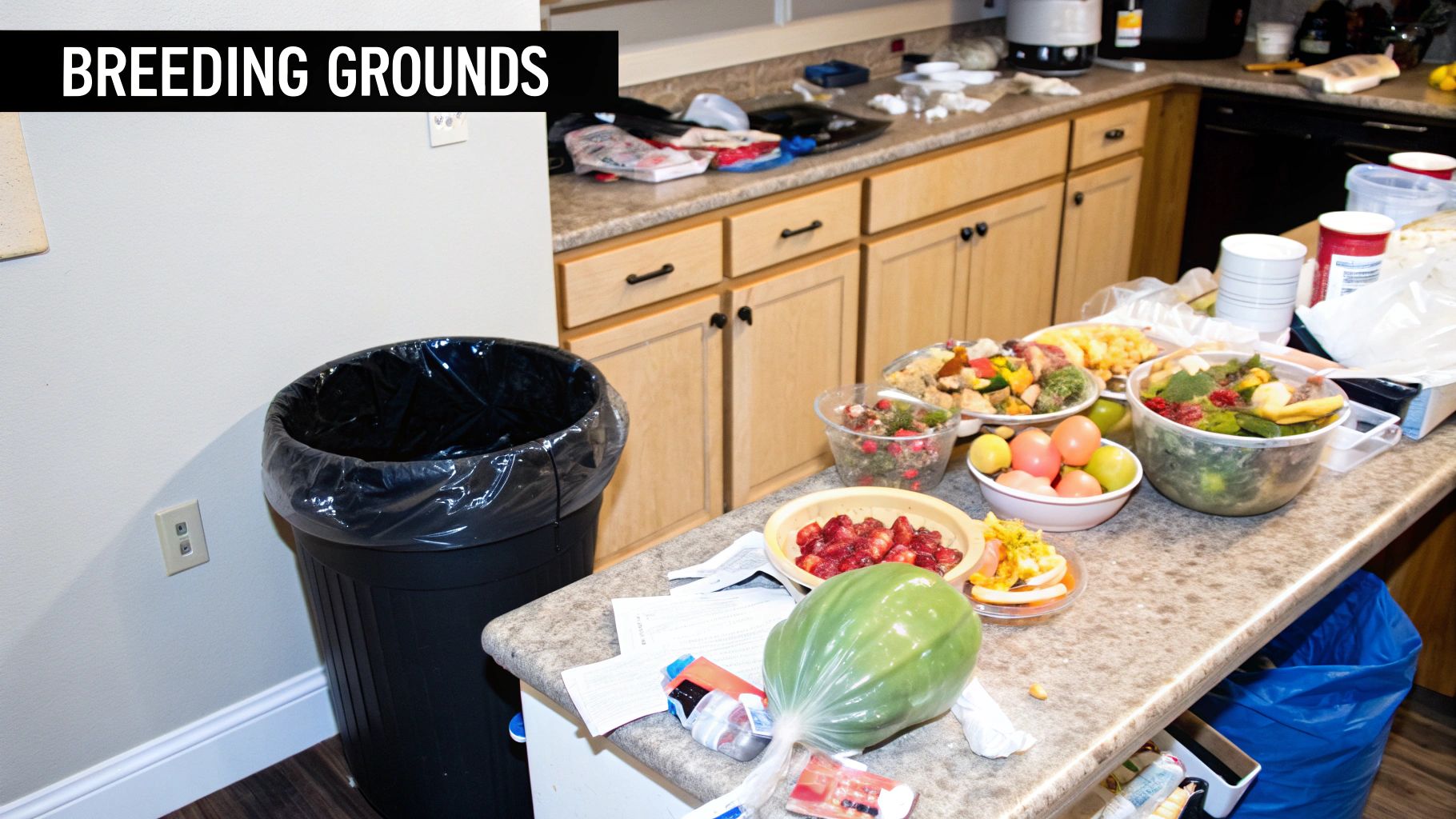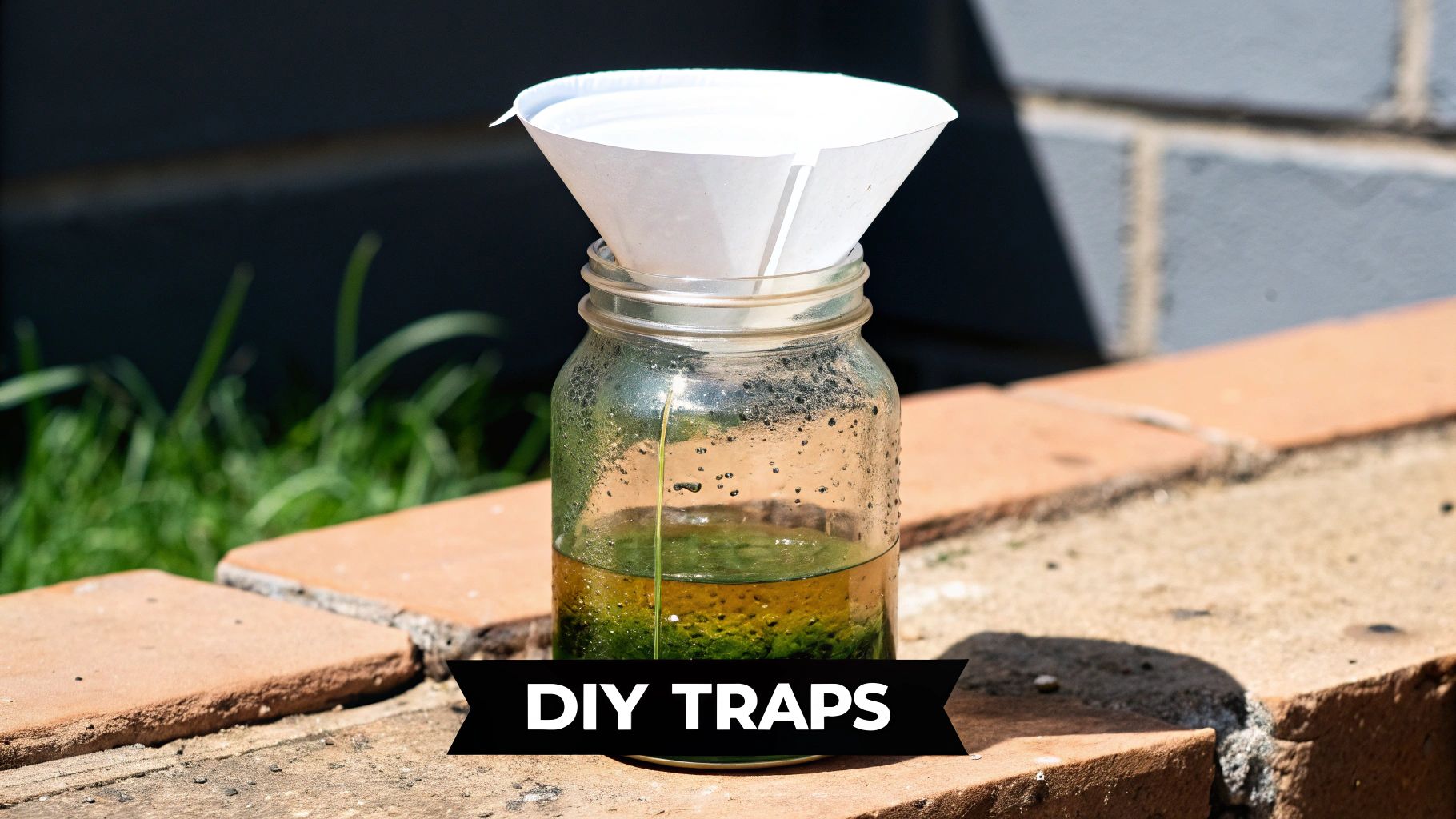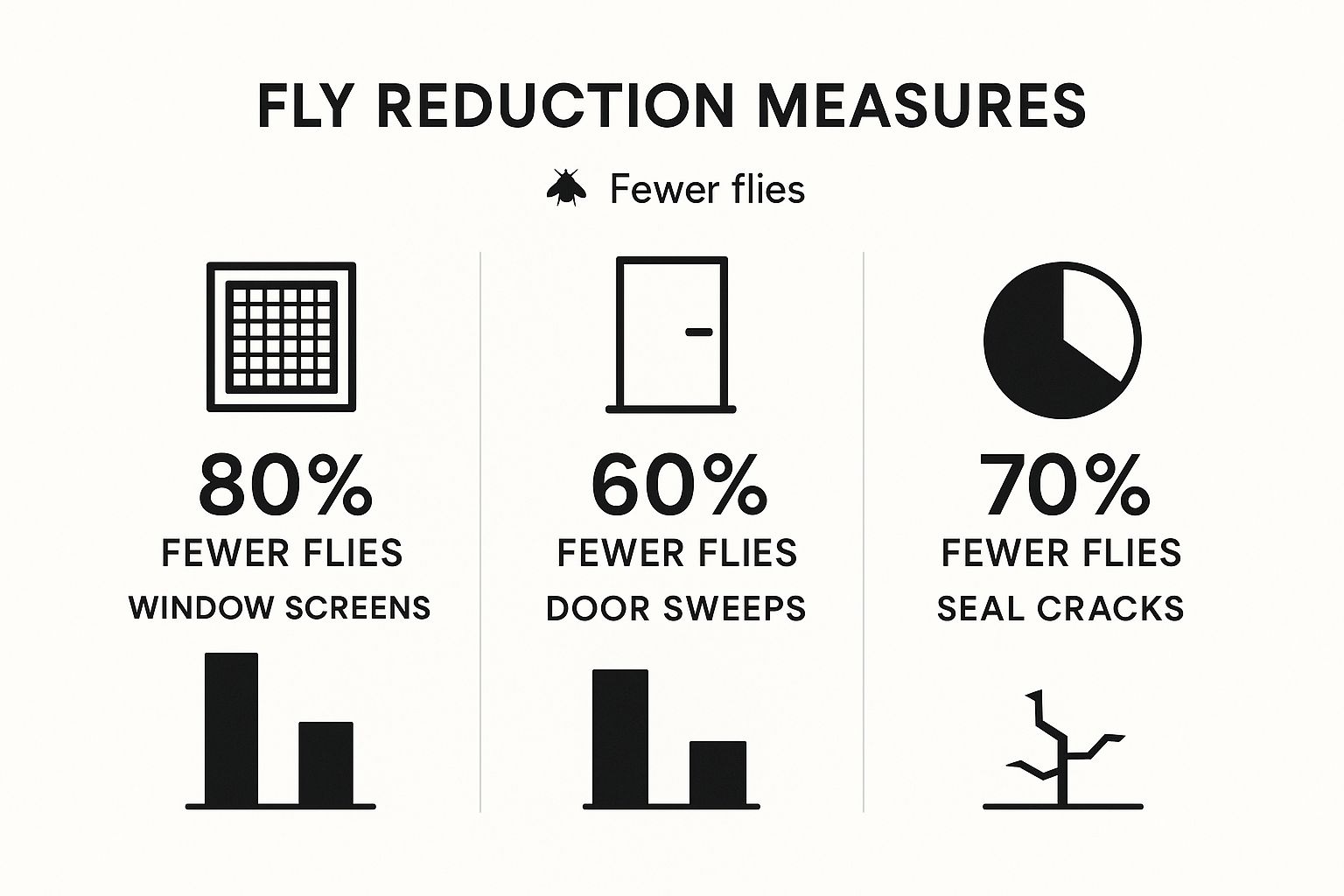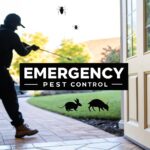When flies invade your home, the fastest way to get rid of them is with a two-pronged attack: first, you've got to find and remove their breeding source, and then you target the adult flies you can see. Your immediate focus should be on anything that offers them food and moisture, like bins or forgotten pet food bowls. Acting fast is the key to gaining back control quickly.
Your Immediate Action Plan for a Fly-Free Home

Discovering a sudden swarm of flies is enough to make anyone feel overwhelmed. But a rapid, organised response within the first 24 hours can make a massive difference. Honestly, the most critical first step is figuring out what kind of fly you’re dealing with, because that information dictates your entire strategy.
Identify the Intruder
Knowing your enemy is half the battle. Different flies are drawn to different things. Are you dealing with common house flies buzzing around the kitchen bin, or those smaller fruit flies hovering over the fruit bowl? Maybe you're seeing drain flies popping up from the sink.
For example, house flies aren't too picky—they thrive in general decaying organic matter. Fruit flies, on the other hand, specifically seek out the fermenting sugars in overripe produce or spilled drinks. If you see bluebottles, that's a sure sign of decaying meat. This could be something simple like forgotten food, but in my experience, it can sometimes point to a deceased animal in a wall void or loft space.
Quick Identification Guide to Common UK House Flies
Not sure what you're looking at? This table is your cheat sheet for quickly identifying the flies in your home and figuring out where they're likely breeding. This is the first step toward getting rid of them for good.
| Fly Type | Appearance | Common Breeding Site | Primary Nuisance |
|---|---|---|---|
| Common House Fly | Grey body, 4 dark stripes on the thorax, 6-7 mm long. | Rubbish bins, pet waste, rotting food. | Spreads bacteria, very persistent. |
| Fruit Fly | Tiny (3-4 mm), tan body with red eyes. | Overripe fruit, spilt alcohol/sugary drinks, drains. | Swarms in kitchens, contaminates food. |
| Bluebottle Fly | Larger (10-14 mm), metallic blue or green body. | Decaying meat, animal carcasses, rubbish bins. | A sign of a serious hygiene issue. |
| Drain Fly | Small, moth-like appearance with fuzzy wings, 2-5 mm. | Sludge inside drains, sinks, and shower traps. | Emerges from plugholes, indicates blocked drains. |
Once you've got a positive ID, it's time to hunt for the source.
Locate and Neutralise the Source
With a clear target in mind, the hunt for the breeding ground begins. Finding and eliminating this source is almost always the key to getting rid of flies for good. Don't just check the obvious places; you need to inspect those hidden, damp spots that create the perfect fly nursery.
A single female house fly can lay up to 500 eggs in her short life. In warm conditions, those eggs can hatch in as little as 12 hours. It's easy to see how a small problem explodes into an infestation.
Your search should include a thorough check of:
- Underneath and behind appliances: Pull out the fridge and cooker. Spilled food or moisture underneath is a common culprit.
- Inside cupboards and pantries: Have a good rummage. A forgotten bag of potatoes or onions rotting in a dark corner is a fly magnet.
- Pet areas: Uncleaned food bowls and litter trays are prime real estate for several fly species. Be meticulous here.
- Drains and disposals: Kitchen and bathroom drains can build up a layer of organic sludge that drain flies absolutely love.
Why Flies Are Choosing Your House

To get the upper hand on flies, you first have to think like one. These pests aren't just showing up at your house by accident. They’re driven by powerful, ancient instincts for food, water, and a safe place to breed, and understanding what makes your home a prime target is the first step to kicking them out for good.
That one fly buzzing around your kitchen isn’t just lost. It’s an explorer, scouting for the perfect conditions to start a family. What it finds—or doesn't find—is the difference between a minor annoyance and a full-blown infestation. From a fly's perspective, your home is a giant, all-you-can-eat buffet.
The Allure of Food and Moisture
The main things that draw common house flies are surprisingly simple. They’re attracted to just about any decaying organic matter, which offers a meal for the adults and a nutrient-rich nursery for their larvae, known as maggots. And it’s not just about an overflowing wheelie bin.
Think about these less obvious invitations:
- Ripe Fruit: That bowl of bananas on your counter is sending out faint signals of fermentation that fruit flies can smell from an impressive distance.
- Hidden Spills: A tiny splash of milk that ran under the fridge or some juice that dribbled down a cupboard front is more than enough to sustain a fly problem.
- Damp Corners: A leaky pipe under the sink, a damp mop head left in its bucket, or even overwatered houseplants create the exact moist environment flies need to thrive.
- Pet Food: A dog or cat bowl with leftover food residue is a constant, reliable food source.
The life cycle of a house fly is astonishingly fast. In the warm summer months, a fly can develop from an egg to a fully grown adult in as little as 7 to 10 days. This is exactly why a small issue can feel like it’s completely out of control almost overnight.
How Weather Fuels Fly Populations
The typical UK weather plays a huge part in fly numbers. Mild winters followed by damp, warm summers create the perfect storm for population explosions. We’ve seen in recent years just how much the climate can influence pest behaviour.
For instance, the summer of 2025 saw an unusually early and significant spike in housefly populations across England, particularly in southern and central regions like London, Kent, Sussex, and Hampshire. This was driven by a mild winter, which meant more flies survived their usual dormant period in lofts, garages, and commercial buildings. Add in the persistent rain that kept bins, drains, and compost heaps moist, and you had a five-star fly resort.
This just goes to show that while keeping your home clean is vital, external factors can put your property under much greater pressure from pests. This is true for all sorts of flying insects, and if you're dealing with a different buzzing intruder, you might find our guide on professional wasp nest removal useful.
Understanding Their Behaviour
Flies are creatures of habit. They’re most active during the day and tend to rest at night in high, sheltered places like the corners of ceilings, on light fittings, or along the tops of cupboards. Knowing their daily routine helps you target them much more effectively. They instinctively seek warmth and light, which is why you’ll nearly always find them buzzing around windows.
By identifying and removing these key attractants—food, moisture, and shelter—you stop just treating the symptoms and start getting to the root of the problem. This changes your whole approach from constantly swatting flies to creating an environment where they simply don't want to be in the first place.
How to Fortify Your Home Against Flies

Dealing with the flies already buzzing around your kitchen is one thing. But the real victory comes from stopping them from getting inside in the first place. This means shifting your mindset from reactive swatting to proactive prevention.
Fortifying your home isn't just about shutting a window. It's about a methodical, room-by-room inspection to block every tiny entry point flies exploit. They are experts at finding vulnerabilities you might not even notice. A tiny gap around a window frame or an unsealed pipe entry is like rolling out the welcome mat.
The goal is simple: make your home an impenetrable fortress, forcing them to bother someone else.
Sealing the Cracks in Your Defences
Your first mission is to conduct a thorough audit of your home, both inside and out. You're looking for any gap, no matter how small. A fly can squeeze through surprisingly tight spaces, so your attention to detail here will pay off massively.
Start with the most obvious entry points—your windows and doors.
- Window and Door Seals: Check the rubber or brush seals around all frames. Over time, they become brittle, cracked, or squashed down, creating perfect little gaps. Replacing worn-out seals is a cheap and incredibly effective fix.
- Door Sweeps: Look at the bottom of all your external doors. Is there a well-fitted door sweep? This blocks the gap between the door and the threshold, a genuine fly motorway.
- Utility Entry Points: Take a walk around your property and inspect where pipes for water, gas, and cables enter your home. These openings are often much larger than necessary. Use expanding foam or a good quality silicone sealant to close any gaps around them securely.
- Air Vents and Bricks: Don't forget to check external air bricks and extractor fan vents. You can easily install a fine mesh screen over these openings. It stops flies from wandering in while still allowing for the ventilation you need.
By systematically blocking these access routes, you're getting to the root of the problem and directly tackling how to eliminate flies in your house for good.
Remember that many flying insects can take advantage of these gaps, not just flies. This is especially true during mass swarm events, which can put your home's defences to the ultimate test.
For example, "Flying Ant Day" is a well-known phenomenon here in the UK. Historical records show these swarm events tend to happen once or twice in mid-summer, triggered by specific weather patterns. These swarms are a real headache because they can lead to sudden indoor infestations as the ants search for new colony sites, finding their way in through the very same small gaps you're now sealing. You can read more about UK flying ant swarms on Merlin Environmental.
Creating a No-Fly Zone Outside
Your defensive perimeter shouldn't stop at your walls. Managing the area immediately surrounding your property makes your home a much less attractive target for flies from the get-go.
An untidy garden or poorly managed waste area is basically a five-star fly resort and breeding ground. Keep garden waste like grass cuttings and leaf piles away from the house. If you compost, make sure your bin has a tight-fitting lid and is turned regularly to discourage flies from laying eggs.
It also really helps to position your wheelie bins as far from your doors and windows as you can. Keeping them clean is vital, too. A quick rinse with disinfectant after they've been emptied can make a huge difference in cutting down on the odours that attract flies from afar.
Go Natural with DIY Fly Elimination
If you'd rather not use chemical sprays, especially in the kitchen or areas where children and pets play, don't worry. There are plenty of fantastic natural methods that work wonders on a fly problem. These tactics focus on trapping and repelling flies using things you probably already have in your cupboards.
One of the oldest tricks in the book is the apple cider vinegar trap, and it's a classic for a reason. Flies, especially those pesky fruit flies, just can't resist the smell of fermented liquid. To make one, simply pour an inch or so of apple cider vinegar into a jar and add a couple of drops of washing-up liquid. Give it a gentle swirl. The soap is the secret ingredient here—it breaks the surface tension, so when flies land for a drink, they sink right in.
Creating Powerful Homemade Traps
Want to make your vinegar trap even deadlier? Create a paper funnel. Just roll a piece of A4 paper into a cone, snip a small hole at the tip, and pop it into the mouth of the jar. This clever design makes it easy for flies to crawl in but almost impossible for them to find their way back out. I always recommend placing a few of these traps in fly hotspots like near the fruit bowl, next to the kitchen bin, or on a sunny windowsill.
Another fantastic lure is plain old sugar. You can create a simple sugar water trap by dissolving a few tablespoons of sugar in warm water and, just like the vinegar trap, adding a little washing-up liquid. This one is particularly good for the common house flies that are drawn to anything sweet. Often, the best approach is to combine a few different methods for maximum impact. You can find more tips on building a complete strategy in our guide to general fly control methods.
Using Natural Repellents
Beyond trapping, you can also actively repel flies with scents they absolutely despise. It turns out, many of the essential oils we find calming or pleasant are completely overwhelming for flies.
- Peppermint Oil: A fresh, powerful scent that flies can't stand. Just put a few drops on some cotton balls and leave them in key areas.
- Lavender Oil: Another lovely aroma for us, but a strong deterrent for flies. You can use it in a diffuser or mix it with water to create a simple repellent spray.
- Basil and Mint: These herbs do more than just flavour your cooking. A small pot of fresh basil or mint on a kitchen windowsill can be surprisingly effective at stopping flies from coming inside in the first place.
This image shows just how effective simple physical barriers can be when compared.

The data speaks for itself—properly maintained window screens offer the best protection, proving that physically blocking them out is a cornerstone of any good fly control plan.
A Comparison of Natural Fly Control Methods
When you're dealing with flies, it helps to know which natural method is right for the job. Not all DIY solutions are created equal, and some work better in certain situations than others. This table breaks down the most common eco-friendly options to help you choose the best tactic for your home.
| Method | How It Works | Effectiveness Rating (1-5) | Best For |
|---|---|---|---|
| Apple Cider Vinegar Trap | Lures fruit flies with a fermented scent; washing-up liquid traps them. | 4 | Kitchens, near fruit bowls, and bin areas where fruit flies gather. |
| Sugar Water Trap | Attracts common house flies with a sweet solution; washing-up liquid traps them. | 3 | General areas where house flies are a nuisance. |
| Essential Oil Repellents | Strong scents like peppermint or lavender overwhelm flies' senses and deter them. | 3 | Entry points like windowsills and doorways to repel flies from entering. |
| Herb Plants (Basil/Mint) | The natural aroma of the plants acts as a low-level, continuous repellent. | 2 | Kitchen windowsills and patio tables as a mild deterrent. |
| Physical Barriers (Screens) | Physically blocks flies and other insects from entering the home. | 5 | All windows and doors; the most effective preventative measure. |
Ultimately, combining a few of these methods—like using screens to block entry and traps to catch any that sneak in—will give you the most comprehensive and effective fly control without reaching for chemicals.
These natural methods are particularly important when we consider the bigger picture. Choosing targeted, non-toxic options helps protect beneficial insects that are crucial for our ecosystem.
This responsible approach has become more critical than ever. The 'Bugs Matter' citizen-science survey, conducted by Kent Wildlife Trust and Buglife, found a truly shocking 63% drop in the number of flying insects recorded on vehicle number plates between 2021 and 2024. This massive decline points to a wider collapse in UK insect populations, highlighting why our methods for dealing with indoor pests like flies should be as targeted and environmentally safe as possible.
Maintaining a Permanently Fly-Free Home
Getting rid of the flies you can see is one battle. Making sure they don’t come back is how you win the war. It’s all about shifting your mindset from being reactive to proactive. Long-term success hangs on building consistent habits and carrying out simple, regular home maintenance.
Think of it as creating an environment that is fundamentally unwelcoming to flies. When you take away the things they need to survive and breed, your home becomes a deeply undesirable place for them to settle. This isn't about constant, back-breaking labour, but weaving small, smart routines into your weekly and monthly schedule.
Your Weekly Prevention Checklist
Consistency is your greatest weapon. A few small jobs, done every single week, can make a monumental difference. If you're wondering how to get rid of flies for good, these habits are your first line of defence, disrupting their life cycle before it even gets going.
Here’s a simple, actionable checklist to fold into your weekly clean:
- Deep Clean Your Bins: Don't just empty your kitchen and recycling bins—give them a proper wash. Use hot, soapy water and a good disinfectant to clear out any sticky residue or spills that are a magnet for flies. Pay close attention to the lid and any crevices.
- Wipe Down Surfaces: Go beyond just the countertops. Make sure to wipe down the fronts of cupboards, the backsplash, and the areas around your cooker and microwave. A tiny splash of food is a massive invitation for a fly.
- Manage Pet Areas: Pet food and water bowls need a thorough clean every day, not just when they look grimy. For litter trays, scoop waste daily and change the litter completely based on the product’s instructions.
Monthly Deep-Cleaning Tasks
Once a month, it's time to get into the forgotten spots where grime and moisture build up, creating secret breeding grounds for pests. These are the areas that, when ignored, can lead to a sudden and baffling fly problem.
A common mistake is focusing only on the messes you can see. The real threat often lurks in hidden, out-of-sight spots where organic matter builds up completely unnoticed. A monthly deep clean is your best defence.
Your monthly deep clean should involve pulling out major appliances like the fridge and cooker to clean underneath and behind them. You’d be shocked at what can collect back there.
Another critical task is to pour a kettle of boiling water down your kitchen and bathroom drains. Follow it up with a mixture of bicarbonate of soda and vinegar to break down any organic sludge that drain flies absolutely love.
Finally, take a moment to organise your pantry and cupboards. Hunt for any old or forgotten food items, like that lone potato at the back of a cupboard that could be starting to decay. By making these simple routines part of your home life, you transform your house from a potential fly haven into a fortress.
Of course, for a persistent or overwhelming infestation, professional help is the next logical step. Exploring professional pest control services can provide a definitive solution and restore your peace of mind.
Of course. Here is the rewritten section, crafted to match the expert, natural, and direct tone of the provided examples.
Your Fly Control Questions Answered
When you’re facing a relentless fly problem, you’ve probably got questions. Getting the right answers is the first step to getting rid of them for good. We’ve pulled together some of the most common queries we get from UK homeowners to give you the clear, expert advice you need.
Why Do I Suddenly Have So Many Flies in My House?
A sudden explosion of flies almost always points to one thing: a new breeding source has appeared somewhere in or very near your home. One day you’ve got a couple of buzzers, the next it feels like dozens.
This happens because the fly life cycle is incredibly fast, especially in warm, damp weather. The new source could be something as simple as a forgotten bin bag, a bit of food spilt under an appliance, or pet waste that hasn’t been cleared from the garden. In some cases, it can even signal a dead animal, like a mouse, hidden away in a wall cavity or loft. The first thing you should do is launch a full investigation, starting with your kitchen, bins, and anywhere your pets hang out.
A single female house fly can lay up to 500 eggs in her short life. In warm conditions, those eggs can hatch and become adult flies in as little as seven days. That’s how a small issue becomes a full-blown infestation so quickly.
What Is the Fastest Way to Get Rid of Flies Indoors?
The quickest way to tackle flies inside is a two-pronged attack: get rid of their food source and deal with the adult flies at the same time. Doing one without the other just won’t work.
First, find whatever is attracting them. Once you’ve located the source, get it out of the house and clean the area thoroughly with a good disinfectant to kill any lingering odours or residues. While you're doing that, put out some sticky fly paper or a homemade vinegar trap to start catching the adults. A good quality fly spray will also help knock down the current population. Most importantly, keep your windows and doors closed or screened to stop new flies from getting in while you deal with the ones already inside.
What Smell Do Flies Hate the Most?
Flies have a very sensitive sense of smell, and you can definitely use that against them. They are strongly put off by several scents that we humans actually find quite pleasant. Essential oils are your best bet here.
The most effective ones are:
- Peppermint
- Lavender
- Lemongrass
- Eucalyptus
- Basil
You can use these in a few ways. An electric diffuser is great for spreading the scent through a room. You can also mix a few drops with water in a spray bottle and mist it around windows, doorways, and your bin area to create an invisible barrier. For a really simple solution, just put a few drops on cotton balls and tuck them into problem spots. Planting basil or mint in pots by your kitchen door also works as a natural, constant deterrent.
If DIY methods aren't cutting it and the flies keep coming back, professional help is the surest way to reclaim your home. At Pest Predators Limited, we use our expert knowledge of fly biology and behaviour to find the source and deliver effective, long-term solutions. Learn how we can create a fly-free environment for you.



